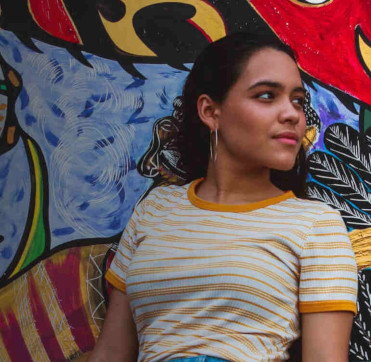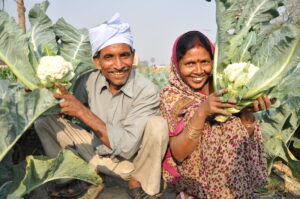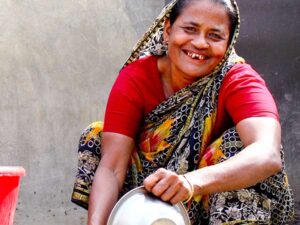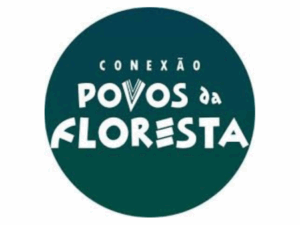Hispanics in Philanthropy is a philanthropic organization funds, scales, and supports Latine-serving nonprofits that are focusing on most pressing issues impacting global Latine communities, including: racial equity, leadership, migration and forced displacement, power building & justice, entrepreneurship, climate justice and gender equity.
Jazmin Chavez of Hispanics in Philanthropy spoke with Ashley Hopkinson on December 14, 2023 Click here to read the full conversation with insights highlighted.
Ashley Hopkinson: Hi, my name’s Ashley Hopkinson. I’m a journalist and editor and manager of the Solutions Insights Lab, and I’m here with Jasmine.
Jazmin Chavez: Hi, Ashley. My name is Jasmin Chavez, and I am the VP of Innovation, Equity and Communications for Hispanics In Philanthropy (HIP). My pronouns are she/her, and I’m currently based out of Denver.
Ashley Hopkinson: What would you say is the problem that HIP set out to solve, and how do you see the work moving towards solving that and addressing that?
Jazmin Chavez: HIP is a 40-year-old organization. We’re the only transnational Latinx-led, Latinx-serving, philanthropic-serving organization. Our mission at the onset was really clear. Less than 1% of philanthropic funding goes to Latine communities, even less for Latin America, and so we were founded on the idea that we had to really move the needle and push more philanthropic resources into Latine communities across the Americas. That’s the original mission. That’s the original goal setting. Today that mission remains true, but it is looking at the ways in which we can accelerate funding and mobilize not just philanthropic donors, but individual donors as well as investors to support Latine organizations, Latine startups in the Americas, but also with a lens and a focus around equity and systems change.
Ashley Hopkinson: What would you say makes the work of the organization distinctive? Would you say it’s strategic philanthropy? How would you describe it?
Jazmin Chavez: I think for us it is a few things. One, we are transnational, so we have a transnational lens to understanding the root causes of issues that impact the Latine communities, whether it’s our Colibri Initiative, which is our climate justice initiative that is looking at the root causes of migration and climate change, and the impact of climate change on Latine communities, and understanding what the challenges are going to be in the years to come, and the ways in which climate change impacts Latine communities, but also communities of color. We have a specific lens around transnational issues that we bring to the sector, and that informs the work. Similarly, we have deep connections to community leaders and community organizations across the Americas. One of our superpowers is being able to build relationships and convene with a lot of these folks to be able to build collective strategies, a lot of capacity building, and a lot of leadership development so that our leaders across the border have the resources that they need.
I think third is really being able to use that expertise to inform the sector in terms of how it is that they can present a Latine centered lens to the work that is inclusive of what they’re already doing. It shouldn’t be anything that is taken away from any of the work that they’re having, but really understanding that there’s a specific lens by which they need to approach the work, whether that’s democracy building, migration, economic justice, even startup, the startup world. We have a startup program as well within our organization, but we really inform a sector of the ways in which they can do that, and then what are the different opportunities that they can move money through us to ensure that they’re reaching the right organizations and the right audiences of how they want to give.
Ashley Hopkinson: Since it’s not direct service, who would you say benefits from the work that you guys are doing, and how would you say they benefit?
Jazmin Chavez: For me, I would say the folks who benefit are definitely nonprofit leaders or startup founders. That is a constituent that we serve, but I think the other group that benefits is philanthropic institutions who are really hoping to support Latinx in their communities. On that side, it’s really being able to present different kinds of philanthropic practices that is informing how they give to the community, but the ultimate recipient of those funds and those resources is always the community.
Ashley Hopkinson: Could you share a story of impact? When you think back to the different work that the organization has done throughout the years, does something stand out to you that illustrates an example of the impact that you’ve made?
Jazmin Chavez: I think there’s two. When Ana Marie took leadership of the organization, I think it was 2018, we were in the middle of the Trump administration, which was not kind to any community really outside of white conservative communities. We were on top of the Muslim ban, the anti-Black everything basically. We were dealing with family separation at the border, and so we were witnessing the children in cages, families locked up. For us in general, the work is deeply personal. I think that’s true across all the affinity groups that are working in philanthropy, but we had to quickly mobilize funders to understand the impact of what was being felt with the organizations who were trying to support families who were being released on both sides of the border, ideally trying to work to combat as well in Mexico and Latin America as people were migrating north, being able to sustain and support the shelters along the way. That was a big part of being able to showcase what that connection was. What we did is that we actually held multiple philanthropic border tours both in the southern region between Mexico and Guatemala, as well as the northern border of Mexico and the United States. We brought funders down for them to understand what the ecosystem actually looks like and who are the nonprofits and the leaders that are doing the work to be able to support migrants and protect migrants as they’re coming up through the route. Through that, we were able to really accelerate funding both in Latin America and also on the US side to organizations who are receiving migrants, which at the time, was just at the border. The strategy has shifted completely today with migrants arriving across different cities, and so the strategy will shift again in terms of how it is that we present the full story to funders so that they understand what the consequences are, and also the ways in which local funders need to support local organizations and institutions that are stepping in where the government cannot.
In 2018 and 2019, we were able to present a picture for them to understand the urgency behind it, and also an opportunity for them to be able to support a collective of organizations on both sides to help us take care of the community. It was not meant to be political. It was literally meant as a humanitarian effort for funders to go firsthand and understand what the impact was and to see the encampments in real time. We also spoke with border patrol, we spoke with authorities in Mexico as well to understand what the governmental impact was. For me was an impactful moment because we were able to scale funding pretty quickly to organizations to the point where there was a shelter at Tijuana where trans migrants specifically, or LGBTQ identifying migrants, could not be placed in the same shelters as others due to safety. We were able to raise enough money for shelters to be able to build specifically for trans migrants to feel safe. There were policies that we were working with and even had border patrol help to separate trans identifying migrants for their own safety as well. It was a multi-pronged effort of providing resources and moving policy at the same time with larger partners. It’s something that stayed with me because I think it showed people just how quickly we were trying to mobilize resources.
We did something similar during COVID. During COVID, basically grant making shifted to COVID response. We were able to provide organizations with funding to be able to provide cash support for organizations, and we were able to move quickly, and I think also start to move partners and the sector to just release what you have. It helped us not be so critical of reporting, how it was used, what was the impact, because we don’t have time for that. Our communities are dying. Give them the money. I feel like that was another really impactful moment in terms of the ways in which we just released funds and encouraged all funders to do the same thing. It had a tremendous impact in terms of how nonprofits were able to shift from whatever their usual mission was to now providing wifi support for students to be able to do work or providing all the personal protective equipment, the masks, the hand wipes, everything. Our spaces became food centers of food collection, so we shifted, I think, to try to support a mutual aid model. That also shifted how we did grant making from that point on for us as well.
Ashley Hopkinson: As an overall measure of success, how do you guys mark out your own measures of success?
Jazmin Chavez: That’s a great question, and I think it’s something that we’re still figuring out. Each program has a different set of evaluation metrics that they use. Some are pretty qualitative where they are looking at X amount of organizations and X amount of funding to be able to go out per year. Then there’s others where we are looking more at the qualitative data of it. For example, our gender equity work out of Mexico is a program that’s about nine years old, and they have significant policy wins, but it’s taken them about six, seven years to be able to inform and push policy at a national level. That has been done through a lot of capacity building, a lot of convenings, a lot of just deep, deep connections with women’s rights and children’s rights organizations in Mexico and then key partners. For them, the metrics weren’t like, “We have to hit this many organizations, and this is the impact,” but understanding that we were moving towards a long-term strategy that was going to support women and children in Mexico and protect them, especially women, because in Mexico we’re dealing with femicides. Domestic violence is a really big issue, and so we were looking at the ways in which we can work with local governments, but also nonprofits to be able to provide support, provide shelter, provide resources, also in anticipation of how we are actually impacting policy. Versus our Lideres fellowship, and the metrics that we use there aren’t necessarily based on the number of applicants, but we’re looking at the qualitative data in terms of how they grow professionally within our fellowship program. What are the skills that they come in at the fellowship at the start, and then where are they when they leave? The added component to that is that fellowship has a healing justice component to it, and so it’s really difficult for us to be like, “Do you feel healed,” when you start the program, but we look at the level of confidence. How comfortable do you feel now holding difficult conversations? How do you feel in terms of your identity within the sector, within the work? Do you feel like you have power or are gaining power in shifting not just organizational, but systemic and community-wide issues and policies?
Every program has a different set of metrics. Overall, we’re tracking where money is going to Latino communities. That continues to be our mission, and we have a dashboard called LatinxFunders.org that we’ve created to be able to track whether or not we’re actually moving that 1% number up or down. It’s not a perfect database because that information is coming in with a two-year delay because we’re using 990 data and information that’s coming in from institutions. We are still trying to refine what better metrics can we use to keep track of this in more real time, but also keep accountable the institutions because if you go to the dashboard, it’ll say that the Ronald McDonald organization is receiving the most amount of funders, and it’s considered a Latino organization, but it’s because they serve Latinos as well, so it’s a blanket approach to how they’re giving. That’s why it’s not a perfect system.
Ashley Hopkinson: Something I wanted to ask you about was your insights and teachable lessons that can be taken from the work that you do that maybe others could use.
Jazmin Chavez: I think for us, always centering on the needs of the community. If folks are building out a strategy, to be able to pause and really see is this actually what the community needs, and not make an assumption of this is what we think it needs to be. I think we’ve done that really well with our power building and justice work that is specifically focused around building power with multiracial organizations in the South and the Southeast, but who are potentially building with Latine communities. We’re funding organizations that are Black led, but they are Latine serving and building collectively with Latine members, and that’s critical. That came about after being in the South, meeting with partners, understanding what the need is and what the gap is, and then building a program around what was asked of us and not having it be top down. Even in that group, once they came together, it’s very much participatory. It’s a participatory learning space so that they self-define what type of capacity building they need, and then we are in charge of finding the resources and bringing that to them. We also help convene them so that they can build out collaborative strategies, but we did that in collaboration, in hearing and talking with the community first.
I think if anyone is coming into this space, the importance of that, especially because between nonprofits and philanthropy, it seems like ivory tower versus on the ground, grassroots folks, and it can be very disconnected, and it can be very intimidating, and it’s intentionally designed to be disconnected. If folks can break down that silo and open up their work and their organization to the community, then that already alone is really powerful work. I think I would probably just start from there, to be honest.
Ashley Hopkinson: I wonder if you could share some takeaways around the area of diversity within your community, because when you were talking about trans migrants and their safety, that made me think so much about the power of storytelling, and even journalism, and when we’re training journalists. Yes, you’re talking about the Latinx community in Oakland, but Oakland is different from the Central Valley. These are different communities. How have you worked through wanting to make sure you serve the diversity of the diaspora of people within the community and the work that you guys are doing?
Jazmin Chavez: It’s very challenging. I mean, even this year we fought over the word Latinx, and where we landed is that we are very good at asking into the communities that we’re entering, “What do you want to be called so that we’re not imposing.” Organizationally, we say Latine because for us, it’s a matter of inclusion, right? It’s not meant to be political, but we want to make sure that we are being absolutely inclusive of how our multiple communities identify, but if we go to New Mexico, we’ll be New Mexico in February, we say Hispanic or we say Hispano. If we’re coming into Texas, we know that we’re talking with Texans or Tejanos. Florida, you’re going to be very country specific. We are fully aware of the different political hats that we wear in terms of even the naming. With that, I think for that reason, we are very careful about being intentional on how we engage with community and being inclusive of understanding the multiple touch points that our communities are going to be encountering.
Florida is such an interesting state for us because we held our conference there two years ago, and the trans ban was happening on top of the anti-immigrant stuff. There was a call for boycotting Florida, and instead of boycotting Florida, we went in and talked with our partners and were like, “If you tell us to boycott, we’ll boycott Florida, unless we hear that from you directly.” They were like, “Don’t boycott Florida. We need money.” “We need the platform. Please come,” and so we didn’t boycott, and we lost funders for that conference because they were upset that we didn’t boycott them, but they were white led funders, and we were very clear. Our community has spoken and said, “Don’t abandon Florida,” so we will not abandon Florida.
It was also an education for us to understand that the trans ban intimately affects the migrant ban. These are things that it’s an unwelcoming space for all, these two identities, but identities that are being crossed. If you’re a trans migrant that is going to impact you, or if you’re a parent, a Latino migrant parent and you are supporting a trans child and transition, there’s big consequences there for someone who’s undocumented parents versus documented parents and what the state can do to them and their children. We really tend to focus on understanding these different points of intersection on the issues and how they impact the broader wheel of our community and also being very respectful in understanding what opportunity we also have to educate folks if we’re speaking with folks in the diaspora. Right now, it really is a big issue in our community with traditional Latino community migrants that have lived here all their life versus newly arriving Venezuelanos who are getting Temporary Protected Status (TPS).
There’s a huge rift in terms of our communities coming up and bumping up against each other. We are still tending to the everyday work around Deferred Action for Childhood Arrivals (DACA) and also trying to be responsive to what we’re seeing happening across the cities and being able to understand and create funding programs or opportunities that both of these things can exist. We have enough room and hopefully enough of an abundance mindset to understand that we can activate donors in these different spaces and be responsive to whatever is coming up for specific communities and also understand that what might be coming up for one is different than what’s coming up for the other.
Ashley Hopkinson: Can describe for me something that you tried that maybe didn’t work so well or didn’t meet your expectations? And what learnings did you take from it?
Jazmin Chavez: Last year we wanted to specifically focus on, how do we create a campaign that holds philanthropy accountable to move us in the next 10 years to increase the amount of philanthropic giving by tenfold in the next five years? We realized that part of it is going to be a data-based project to be able to gather some of the missing data, get it more in real time, and have it be accurate. How much of funding is actually going to either Latinx-led or Latinx-serving organizations that are proportional to the Latino communities that are within their areas? If you’re in Chicago, how much of Chicago funding is going to the Latino community based on the population size of Latinos in Chicago? Not just like, “Well, we give to all,” because that’s not proportional, and it doesn’t necessarily fully address the needs of the community, and that data isn’t set out in that way.
The second part to that is also building a narrative campaign and the importance of the power of Latinos and the importance to invest in our communities because with or without them, we’re going to thrive, but it’d be better for you to invest in it. We have this challenge all the time, which is to be able to create a narrative campaign that does that without excluding or asking to take away from giving to the Black, Asian, Indigenous, AAPIP organizations, and they could come off that way. To be able to speak to funders and say, “We’re asking for a piece of the pie in terms of what’s owed to everybody and not just the whole pie should come to us,” that’s already a challenge on top of trying to access, how do you define Latinx led? Are we looking at the board? Are we looking at the leader of the organization? Are we looking at the staff composition?
Then you couple that with the affirmative action decision that then also is putting philanthropy in a difficult position because there’s a push to philanthropy to stop focusing on race-based funding models. There’s very much a threat to stop that. We built this campaign in real time, and we were also working specifically with the Latino community foundations (LCF) first to be able to show that if they could fund the project, ideally for us, this was a collective project that would be funded for us to be able to get the data, the research and the narrative campaign up and off the ground, but LCFs are historically underfunded. That was already a flawed strategy in terms of having us as a larger intermediary come in and say, “Hey, can you give them some funding? Can you give us funding?,” not to create a fund because we’re not creating a fund.
We’re creating an accountability model, and campaign, and data metrics to be able to keep larger funds to be accountable. That wasn’t well received. I understand that. I think a part of, as we were building it out, we were thinking that it’d be good to have our LCFs behind us in solidarity, but it wasn’t the right approach to go ask them for funding. The ask needed to be different there, and the funding request should have gone really to some of these larger philanthropic groups to hold them accountable. If you’re really down to fund Latine community issues, then we need you to be a partner in this.
It just was a failed strategy. I think we were anticipating it to be more narrative-based at the beginning. I feel like I had made it clear that the data part is the biggest part of this, the data part, but on our staff, we don’t have a research data specialist, and so we spoke with a lot of different data consultants, but the scope of it is massive. The price to fund a database research project where there’s a lot of dirty data cleaning, a lot of having to work with institutions to ask for their information, it was just the scope was much bigger than I think we realized, and it turned out to be a failed strategy. That campaign was called Impact Latinx.
We are coming back to a space where I think we’re in a much better space where the data project is the main focus of it for now, and having us be a partner, and identifying what do we mean by Latine-led and Latine-serving, and then also being able to work with nonprofits to gather their information so that there is one highlight of organizations that are doing incredible work across the country, the leaders, and the why, being able to say, “Here’s the data and this is the gap, but look at the incredible work that’s happening and where you can put your money.” There’s no shortage of what you can find depending on what institutions or individual funders are looking at.
Ashley Hopkinson: Aside from funding, what would you say are the larger outside challenges you face?
Jazmin Chavez: I think definitely the DEI moving away from race-based grant making is a huge problem just because we’re seen as a racist for trying to remedy racial inequality, which is just mind-blowing to me, but it has had a huge impact on even fundraising in trying to get attention and momentum for these types of things. But, I also think public perception, I don’t think we were very clear about what the strategy was. The public perception was very much on the nonprofit side was like, “Well, we want to be involved, we want to get funding,” but it wasn’t a fund. It was the idea to move money to these organizations and be able to speak with local community foundations to move money at a localized level. I think the public perception of it was just unclear as to what it was and how we were going to do it.
Ashley Hopkinson: How would you say HIP is working towards advancing systems level change?
Jazmin Chavez: I think it’s a combination of a lot of things. I think part of it is we do have the capacity to build our own technology to simplify giving to our communities, and we have a larger database project to be able to build a space similar. I don’t know if you’ve heard of Giving Gap or the BackBlack campaign. At the height of George Floyd, the full spectrum of what we saw in 2020 around race relations and anti-Blackness. They did a really wonderful job of pulling together a list of nonprofits that were Black-led so that funders and people could give to Black-led organizations. For us, we feel like we are doing something similar now around pulling together Latino organizations and the ways in which people can support across a variety of issues.
The technology side I think is one way in which we are able to influence change because we especially work with a lot of nonprofits who don’t have crowdfunding or fundraising capabilities, and so we come in and help them with that. I think the second thing is the capacity building work that we do. We do a lot of work around general operating capacity building, but also healing justice approaches to ensure that community leaders are having the space to be able to pause, and reflect, and also build collaboratively and not in silos, and push forward collective agendas. I think that’s what our gender equity work, and our power building work, and to a certain extent, our migration work has been able to do. This collective gathering of leaders and organizations for wellness, but also to push things forward collectively has been something that has been, I think, within our wheelhouse of how we’re looking at systemic change.
Ashley Hopkinson: What would you like to see from other partners in this space?
Jazmin Chavez: Well, we should not wait until a crisis for sure. I think a lot of times folks think it’s either, or. It’s either we fund Indigenous groups doing this or Latinos, but we’re not going to fund both, and a lot of times we’re dealing with the same issues. If we’re dealing with community policing, all of us are dealing with that. Can you create a strategy that is also bringing in the lens of Latinos and these experiences and the organizations that are doing this work so that you’re able to fund everybody and not have it turn into this war of resources. I think that’s one of the most important things for funders is they should be centering Latinx strategies within all of their work.
There’s nothing that doesn’t impact Latinos. It’s not just migration. It’s from economic justice to education reform. Everything they can think of impacts our communities and it impacts them. It might be in different ways, but nonetheless it impacts them. These groups are looking to build, but perhaps because of a fight for resources, they tend to not associate or build together, but if you can create a space that is actually encouraging them to build together and providing the funding for everybody to build together, then we can create even larger impact, and build these relationships, and move policy, and actually move systems at that time. That for me is something that I’d like to tell partners is that these strategies and these grant-making things shouldn’t be in isolation, but it should be inclusive of.
Ashley Hopkinson: What do you hope to see HIP evolve into in the next five years? What would you like to see?
Jazmin Chavez: That’s a great question. I think continuing to be able to present a transnational lens to the work in the sector I think is really important. I would love to see us move that number significantly for the next five years with key partners, but I’d also love to see us pushing forward an agenda that does center the experience obviously of Latinos and what we’re encountering, but in collaboration with others. I don’t mean just a political agenda. Economic justice are things that are not political. Everyone should have the opportunity to thrive, schooling, everyone should have the opportunity to be able to receive a great education, everyone should have food in their bellies. We shouldn’t be fighting. At a basic minimum, being able to set an agenda where we are able to create policies, and strategies, and accountability models where our communities are being pushed to thrive and not just to go back into survival mode.
I think that’s going to be really hard depending on what happens next year, but for me, the vision is for HIP to be able to set those types of agendas and be a model in terms of how we lead and build together and collectively. Yes, our vehicle is through Latinos and Latinidad, but we can also model what it looks like to do that in collaboration with others as well.
Ashley Hopkinson: What keeps you inspired and keeps you in this work?
Jazmin Chavez: Man, I don’t know if it’s inspired, but the urgency. I mean, I’m inspired deeply by leaders across the country who are doing incredible work. We have Greisa Martinez who leads United We Dream and is getting ready for the DACA fight. I am inspired by her and her vision for what we need to do to protect Dreamers. I’m also pushed to find resources, and support her, and organize donors to support that vision.
For me, I feel like I’m very much a servant to leaders, to our non-profit leaders, because it’s them who should be telling us where our focus needs to be. It continues to be obviously super under-resourced and under-funded, but they keep me inspired, and they keep me motivated and a fire in my belly to like, “I have to find funding, I have to figure out how I can get money to them. I have to figure out how we mobilize the South in the next 5, 10, 15, 20 years. What does that look like?” For me, I get inspired very much by the leaders who are doing this work every day and a commitment to these are the folks that are going to make life better for my littles, right? I have a 16-month-old and a 7-year-old, and I want them to be able to exist and live in a world where their identity and their existence isn’t something that is questioned or isn’t made to feel like they don’t belong. It’s these leaders for doing that for me.
Ashley Hopkinson: That’s wonderful. Thank you.
Click here to read the full conversation with insights highlighted.
Ashley Hopkinson is an award-winning journalist, newsroom entrepreneur and leader dedicated to excellent storytelling and mission-driven media. She currently manages the Solutions Insights Lab, an initiative of the Solutions Journalism Network. She is based in New Orleans, Louisiana.
* This interview has been edited and condensed.
Learn about other organizations that provide social innovations in philanthropy.






